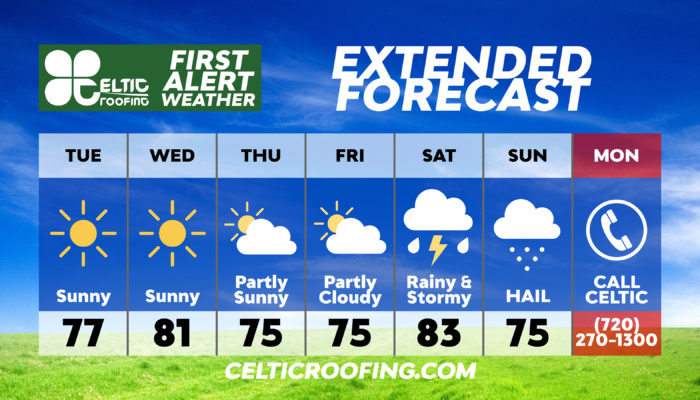The Problem
We’re certain you’re tired of hearing about hail, as it’s talked about ad nauseam. Gosh, we’re sick of it, too! But it’s important to remember that it’s an undeniable part of life in Colorado. So what can be done about it? Do we hope and pray it won’t be too bad this year? Do we force a smile and pretend those hail divots on our roof and gutters don’t exist? How about we acquiesce and replace our roofs every other year. (The answer to all these rhetorical questions is a resounding NO)
The Solution
You know the sure things in life. In Colorado, it’s death, taxes, and hail. While we can’t help you with death and taxes, we’ve got you covered on the hail part.
-
Celtic offers every client an upgrade to a class-4 hail rated shingle … for free.
-
Celtic works for you, and will be on-site when the insurance adjuster is looking at your roof to make sure the siding, gutters, windows, fences and even your mailbox are examined. As we’ve been around for over two decades, we have wonderful business relationships with insurance companies, and we love working with adjusters. Our goal is to make sure ALL damage is inspected, and ALL damage is repaired or replaced.
-
Celtic is a local, family-owned business, and as such, we understand the importance of protecting your home and family. Whether it’s rain, sleet, snow, hail, high winds, or excessive sunshine, we know the climate and we know how to protect against it. Our expertise in all types of roofing allows us to not only assess damage, but we can also formulate a plan to ensure the highest protection of your property. We absolutely love our clients, but we don’t want to be seeing you again for a very, very long time (no offense, of course).
Why Does Colorado Get So Much Hail?
You’ve likely heard of “tornado alley,” which is a loosely defined area in the central United States where tornados are very common, but did you know there is a “hail alley” as well? This area overlaps much of what is traditionally considered tornado alley along with states like Minnesota, Missouri, and Colorado. So, what makes these states like Colorado so hail-prone? It mainly has to do with elevation. Hail forms in the cold air above us, so at higher elevations, it doesn’t have as far to fall and potentially melt before making impact with the ground. Colorado has the highest average elevation of any state, meaning we are much closer to the freezing level in the atmosphere, making hail even more likely.
How Hail Can Damage Your Roof
Depending on its size, a piece of hail can make impact traveling anywhere from nine to 40 miles per hour. Obviously, the larger the hailstone and the faster it’s traveling, the more damage it can do to your roof. Hailstones can bruise, crack, and tear away at roofing shingles which not only threatens the structural integrity of your roof but can also lead to water damage.
Common Signs of Hail Damage
It’s often hard to identify signs of hail damage to your roof. This is not only because it can be challenging to safely get up to your roof and check, but the signs can look insignificant or be too small to notice. Thankfully, there are a few tell-tale signs of hail damage that anyone should be able to spot. These include:
- Shingles, tiles, or granules on the ground.
- Leaking or clogged gutters.
- Shingles that have been cracked or broken.
- Shingles that are peeling off.
- Missing shingles.
- Water damage or leakage inside of your home.
- Damage to your home’s exterior and windows.
What To Do Next
Give us a call. We promise we don’t bite! The Celtic Clan will head over to your home or business and do a free inspection of your property. Once we assess the situation, we’ll send you a full rundown of your options. You can rest assured that we will make the process simple, easy, and maybe even a little fun (we have a wonderful Team!). 720.270.1300
Get Your Free Inspection
